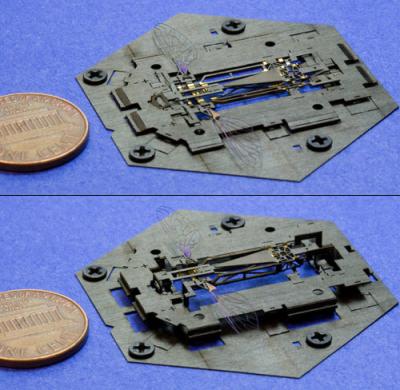Several clones of robotic insects will be soon mass-produced from a single sheet, a technique that has found its inspiration from children’s pop-up books and origami.
 The Harvard Monolithic Bee (or "Mobee") pops up within an assembly scaffold, which performs more than 20 origami assembly folds. Credit: Photos courtesy of Pratheev Sreetharan, Harvard School of Engineering and Applied Sciences.
The Harvard Monolithic Bee (or "Mobee") pops up within an assembly scaffold, which performs more than 20 origami assembly folds. Credit: Photos courtesy of Pratheev Sreetharan, Harvard School of Engineering and Applied Sciences.
The innovative layering and folding technique that was formulated by the Harvard engineers will enable speedy fabrication of not only microbots but electromechanical devices. The prototypes include lamination of 18 layers of carbon fiber, Kapton, ceramic, adhesive sheets titanium and brass together in a complicated, laser-cut design. The structure includes flexible hinges that enable the 2.4 mm height product to assemble in a single movement similar to a pop up book.
For several years, the engineers at Harvard Microrobotics Laboratory at SEAS such as Sreetharan, Whitney, and their colleagues have been constructing bio-based, bee-sized robots capable of aviating and behaving independently as a colony. The RoboBees project implementation required that the right materials, control systems, hardware and fabrication methods be designed, developed and integrated by a large number of researchers. The new process is based on locking mechanisms and dip soldering and facilitates the use of cured carbon fiber, which is stiff, simple to align and resembles a wet tissue paper.
According to the principal investigator, Rob Wood, the new technique allows the use of any kind of material such as metals, polymers, composites and ceramics. He added that it will be possible to fabricate complete systems in any 3-D shape since any type and number of material layers can be incorporated along with integrated electronics.Self assembling devices have also been demonstrated by the team using pre-stressed materials.
The Harvard Office of Technology Development has currently formulated a strategy to commercialize this technology. The effort has been initiated with filing-up of patent applications and association with several companies, entrepreneurs and venture capitalists to discover the complex applications in a variety of industries.